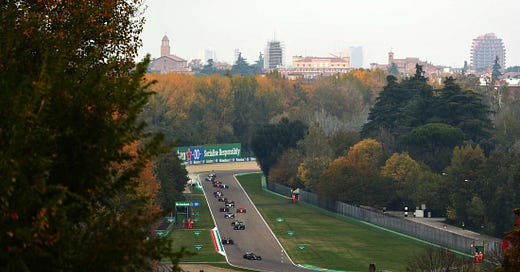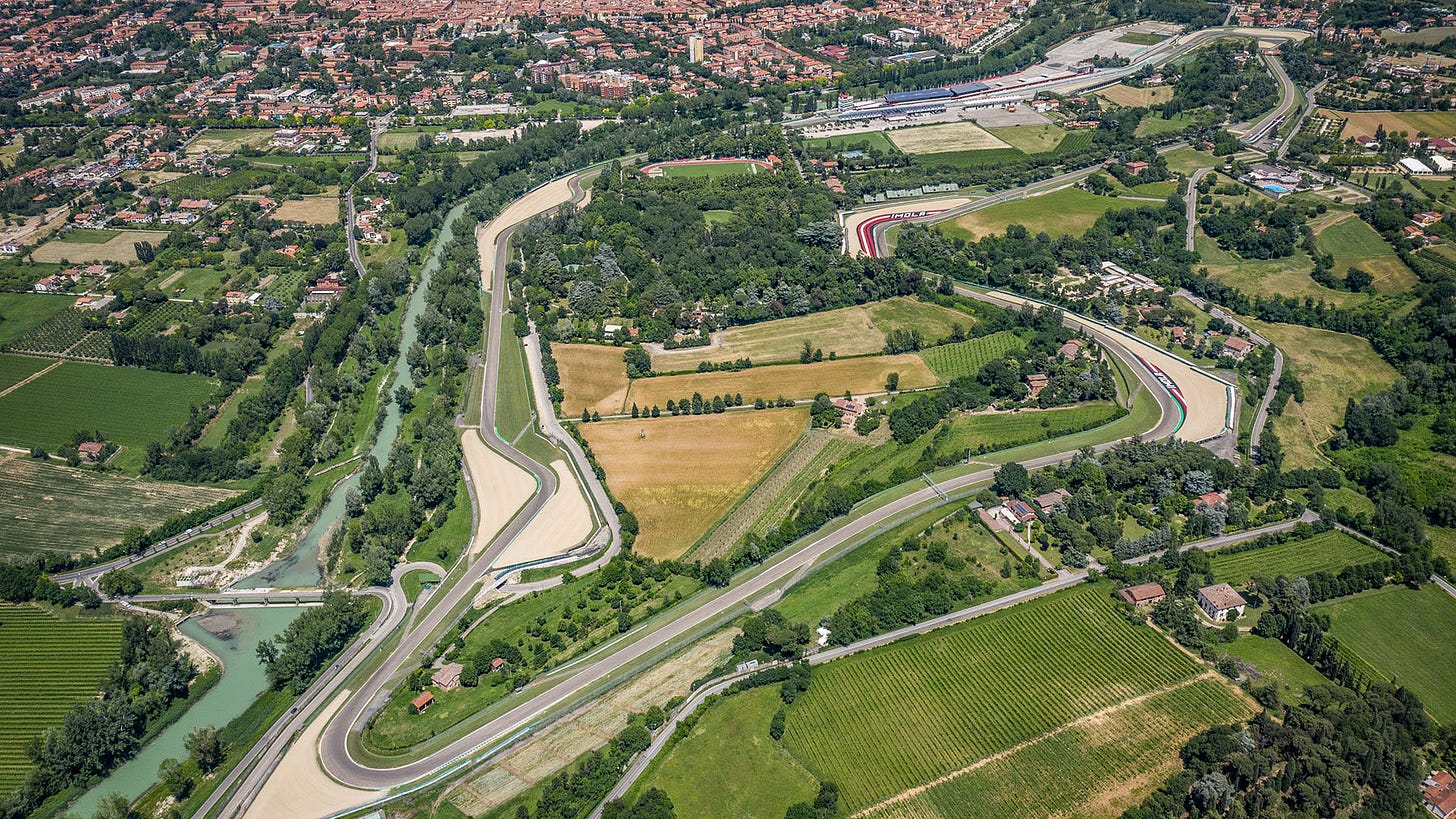Welcome to Business of Speed.
In case you missed it:
If someone forwarded you this email, consider supporting independent coverage and analysis of the business of Formula 1.
There’s a 22,446 km2 stretch of land in northern Italy where speed and slowness live side by side.
It’s not the kind of contrast that screams at you. It hums. You feel it in the cobblestones, in the silence of a good pecorino, in the low growl of a V12 warming up at Fiorano. And if you’ve ever walked through the gates of Imola—not just as a fan, but as someone paying attention—you know exactly what I mean.
My family is from Campania, in southern Italy, but Emilia-Romagna might be my favorite region. That’s saying a lot for a country that over-delivers on every cliché. But there’s something different here: something lived-in that resists performance and insists on practice.
People call it the Motor Valley, which makes it sound like a theme park. In reality, it’s a pilgrimage. Ferrari, Lamborghini, Pagani, Dallara, Maserati, and Ducati were born and built here.
These are brands that don’t just make vehicles but cast spells. Not for effect. For excellence. These factories are shrines of mechanical fidelity. And they all exist within an hour’s drive of each other, nestled between vineyards and churches and grandmothers who know 37 ways to make ragù.
This region doesn’t sell “Made in Italy” as a slogan. It breathes it.
And that’s why the conversation around Imola’s future on the Formula 1 calendar frustrates me.
The chatter goes like this: Imola is too narrow. Not enough overtaking. The modern F1 car is too big. Not entertaining enough. The sport doesn’t need two races in Italy; it could have one in Kyalami, Seoul, or New York. These are the arguments of spreadsheets, not street corners.
But here’s what doesn’t make the bullet points.
In the last 12 months, Imola completed €775,000 in trackside infrastructure upgrades—new pit boxes, flood defenses, paddock reinforcements—on time and without spectacle.
The train station was renovated, and new high-speed routes connected directly to the circuit. Daily capacity has grown to 92,500, and ticket sales are booming. The local government, national officials, and even the Republic of San Marino are aligned in support.
This isn’t some heritage track resting on faded laurels. It’s a regional project with modern ambitions and ancient roots.
More than that, it’s a place that understands the difference between hosting an event and being one.
You can redline a Ferrari in the morning, lunch on tortellini folded by hands older than your car lease, and finish the day standing at the Variante Alta where Senna once floated through curves like a ghost in a silk suit.
You don’t get that in Miami. You don’t get that in Vegas. You don’t even get that in Monza, a cathedral to speed but not necessarily to craft. Imola is different. It’s small. Intimate. Human.
There’s no need for a drone shot to tell you it’s beautiful. You’ll feel it in the espresso you sip, standing next to a retired mechanic who still refers to engines like they’re family.
Formula 1 says it wants to grow, to become more than a European sport, and to find new markets. I get that. Expansion isn’t the enemy, but replacing depth with scale is.
The soul of F1 doesn’t live in the carbon fiber. It lives in the tension between the past and the present. In the knowledge that what you’re watching right now is connected to something older, deeper, more elemental than lap times and tire strategy.
Imola is part of that connection. It’s not perfect, but neither is sport.
Anthony Bourdain once said, “Context and memory play powerful roles in all the truly great meals in one’s life.” I’d argue the same applies to races.
You can’t measure what Imola feels like in DRS zones. You have to be there to taste it.
And if F1 lets that go, it’s not just losing a venue. It’s losing part of itself.
75 Years of Speed, Innovation, and Champions
Formula 1 is 75 today.
Three-quarters of a century since silver bullets roared through Reims. Since Fangio danced with physics. Since Enzo muttered, “aerodynamics are for people who can’t build engines.”
Formula 1 is where obsession, courage, and engineering collide at 200mph; milliseconds decide legends, every corner remembers a ghost, and every straight beckons the brave.
75 years of names etched into myth: Senna in the rain. Schumacher in scarlet. Lauda, with his face half gone, but the fire still lit. Prost, cold as calculus. Hamilton, rewriting history. Verstappen, unrelenting in a modern machine.
But F1 has never just been about drivers. It's about the mechanics who sleep on pit floors. The designers who reimagine airflow. The strategists play chess while the world blurs by. It’s about people who look at the impossible and say, “give us a weekend.”
And still, after 75 years, we watch. We feel. Our hearts quicken on formation laps. We hold our breath into Turn 1. We fall for the story over and over again.
Because F1 is the last place humans and machines chase perfection in public.
Loudly. Furiously. Beautifully.
Here’s to the next 75.








Brilliant piece, every word resonates on how I feel about this circuit. It is criminal to even think of replacing this circuit with any of the Middle East or US circuits.